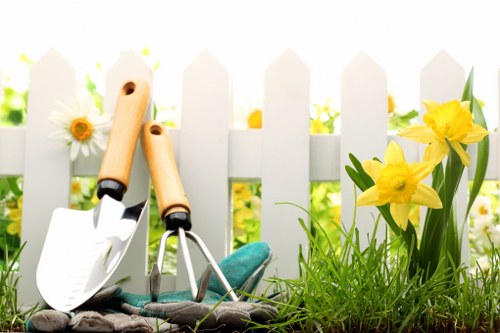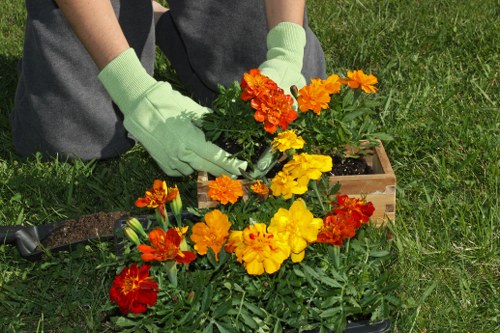Lawn Mowing Shacklewell: Your Ultimate Guide to a Beautiful Lawn

Introduction to Lawn Mowing in Shacklewell
Maintaining a lush, green lawn is a source of pride for many homeowners in Shacklewell. Proper lawn mowing not only enhances curb appeal but also promotes the health of your grass. Whether you’re a seasoned gardener or a beginner, understanding the best practices for lawn mowing in Shacklewell is essential.
Shacklewell’s unique climate and soil conditions require specific lawn care techniques. By following these guidelines, you can ensure your lawn remains vibrant and healthy throughout the year.
In this article, we will explore the key aspects of lawn mowing, from choosing the right equipment to understanding the local conditions that affect your grass.

Choosing the Right Lawn Mower
Selecting the appropriate lawn mower is crucial for effective lawn maintenance. There are several types of mowers available, each suited to different lawn sizes and grass types.
1. Push Mowers: Ideal for small to medium-sized lawns, push mowers are easy to maneuver and require minimal maintenance.
2. Self-Propelled Mowers: Suitable for larger lawns, these mowers reduce the effort needed to push and are excellent for hilly terrains.

Optimal Mowing Height for Shacklewell Lawns
Maintaining the correct mowing height is vital for a healthy lawn. In Shacklewell, the recommended mowing height typically ranges between 2.5 to 3.5 inches, depending on the grass type.
Setting your mower to the appropriate height encourages deep root growth, making your lawn more resilient to drought and pests.
Remember to adjust the mowing height seasonally to adapt to changes in weather and grass growth patterns.

Seasonal Lawn Mowing Tips
Different seasons require different lawn care strategies. In spring, focus on removing debris and mowing regularly to encourage new growth.
During summer, mow less frequently but at a higher setting to help your grass retain moisture.
In autumn, reduce mowing frequency as the grass growth slows down, and prepare your lawn for the winter months.

Common Lawn Mowing Mistakes to Avoid
Avoiding common mistakes can significantly improve the health and appearance of your lawn. Here are some pitfalls to watch out for:
- Mowing Too Short: Cutting grass too short can stress the plants and make them more susceptible to weeds and diseases.
- Inconsistent Mowing: Irregular mowing can lead to an uneven lawn and hinder grass growth.
- Ignoring Mower Maintenance: A poorly maintained mower can damage your lawn and reduce mowing efficiency.

Local Expertise: Lawn Mowing Services in Shacklewell
For those who prefer professional assistance, Shacklewell offers a range of lawn mowing services tailored to meet your specific needs.
These services include regular mowing schedules, lawn aeration, fertilization, and pest control, ensuring your lawn stays healthy and beautiful year-round.
Hiring a local expert can save you time and ensure your lawn receives the care it needs from professionals who understand the unique conditions of Shacklewell.

Eco-Friendly Lawn Mowing Practices
Adopting eco-friendly practices not only benefits the environment but also enhances the health of your lawn. Consider the following tips:
- Use a Mulching Mower: Mulching mowers recycle grass clippings, returning essential nutrients to the soil.
- Limit Chemical Use: Opt for organic fertilizers and natural pest control methods to maintain a healthy ecosystem.
- Water Wisely: Water your lawn early in the morning to reduce evaporation and encourage deep root growth.
Implementing these practices can lead to a greener, more sustainable lawn.

Tools and Accessories for Efficient Lawn Mowing
Having the right tools can make lawn mowing more efficient and enjoyable. Essential tools include:
- Sharp Mower Blades: Keeping your blades sharp ensures clean cuts and reduces grass damage.
- Rakes and Leaf Blowers: These tools help prepare your lawn before mowing and keep it clean afterward.
- Lawn Bags: Collecting grass clippings can help maintain a neat appearance.
Investing in quality tools and maintaining them properly will enhance your lawn care routine.

Understanding Shacklewell’s Soil and Grass Types
Shacklewell's soil composition and climate influence the types of grass that thrive in the area. Common grass types include fescue, ryegrass, and bluegrass.
Understanding your soil type—whether it's sandy, clayey, or loamy—can help you choose the right grass and lawn care practices.
Soil testing is recommended to determine nutrient levels and pH balance, allowing you to tailor your fertilization and irrigation accordingly.

Maintaining Lawn Health Throughout the Year
Consistent care is key to a healthy lawn. Regular mowing, watering, and fertilizing keep your grass in optimal condition.
Address pest infestations and weed growth promptly to prevent long-term damage. Additionally, aerating your lawn annually helps improve soil health and root growth.
By staying proactive with your lawn maintenance, you can enjoy a beautiful outdoor space year-round.
Conclusion
Maintaining a beautiful lawn in Shacklewell requires attention to detail and an understanding of local conditions. From choosing the right mower to adopting eco-friendly practices, each aspect of lawn care contributes to a healthy and vibrant yard.
Whether you decide to mow your lawn yourself or hire a professional service, the tips and strategies outlined in this guide will help you achieve the lawn of your dreams.
Frequently Asked Questions
1. How often should I mow my lawn in Shacklewell?
Generally, you should mow your lawn once a week during the growing season. However, frequency may vary based on grass growth rate and weather conditions.
2. What is the best time of day to mow the lawn?
The best time to mow is in the late morning after the grass has dried. Avoid mowing early in the morning or late in the evening when dew is present.
3. How can I prevent my mower from leaving tire marks?
Ensure your mower blades are sharp and set at the proper height. Mowing in different directions each time can also prevent tire marks from forming.
4. What should I do if my grass is turning brown?
Brown grass can be a sign of drought stress, disease, or pests. Assess your watering practices, check for signs of pests, and consider aerating or fertilizing your lawn to promote recovery.
5. Is it necessary to hire a professional lawn mowing service?
While not necessary, hiring a professional can save time and ensure your lawn receives expert care, especially if you have a large or complex yard.